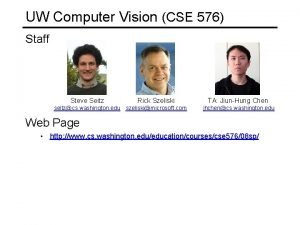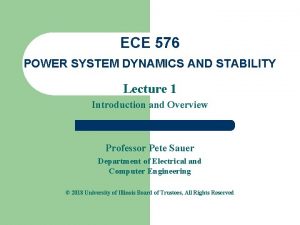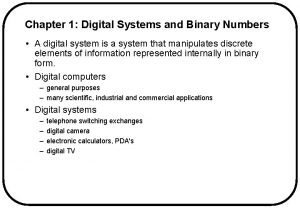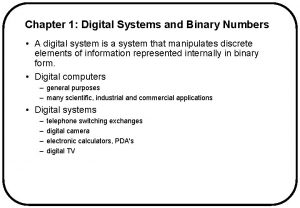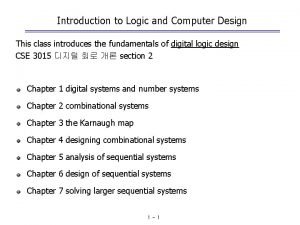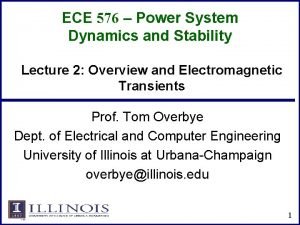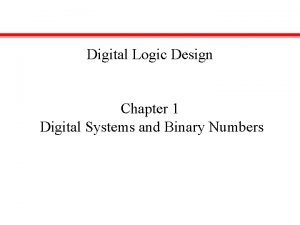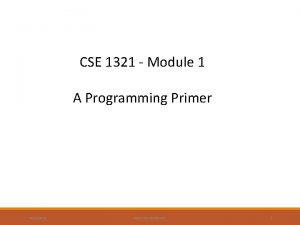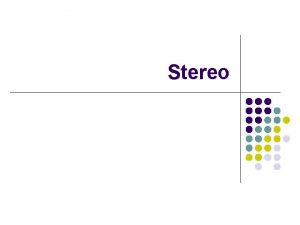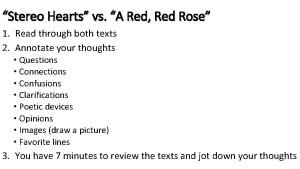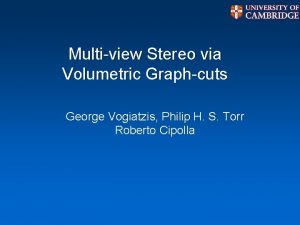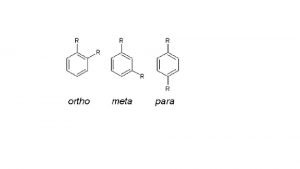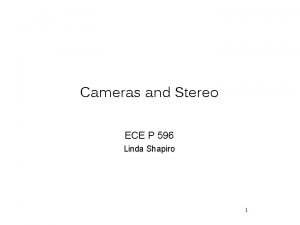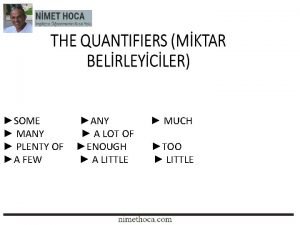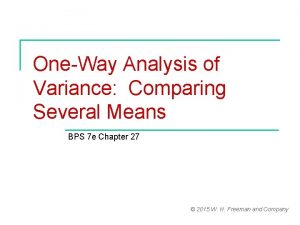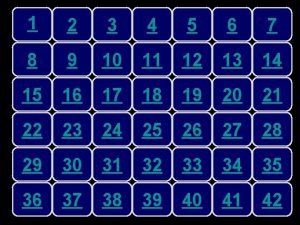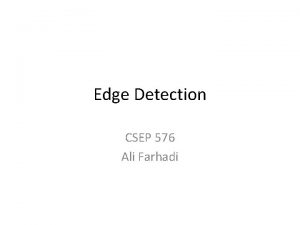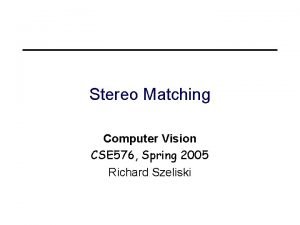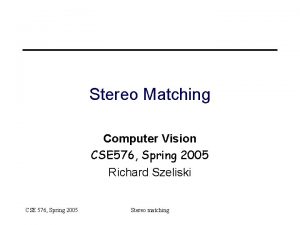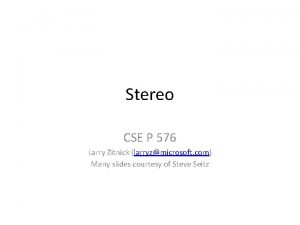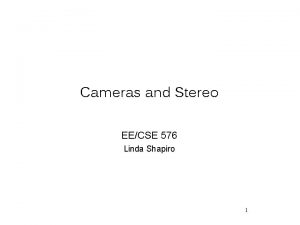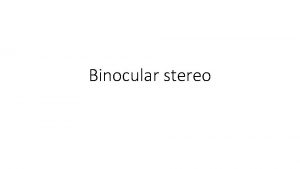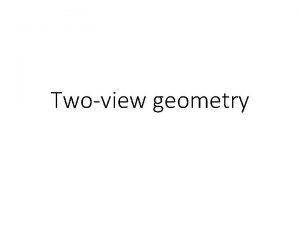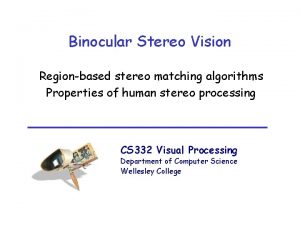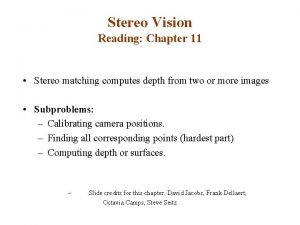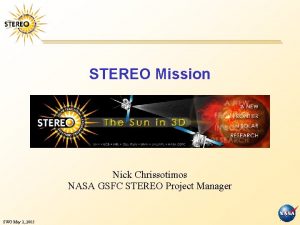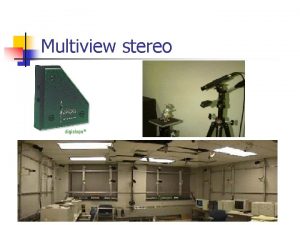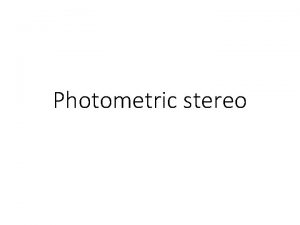Stereo CSE 576 Ali Farhadi Several slides from
























































































- Slides: 88

Stereo CSE 576 Ali Farhadi Several slides from Larry Zitnick and Steve Seitz


Why do we perceive depth?

What do humans use as depth cues? Motion Convergence When watching an object close to us, our eyes point slightly inward. This difference in the direction of the eyes is called convergence. This depth cue is effective only on short distances (less than 10 meters). Binocular Parallax As our eyes see the world from slightly different locations, the images sensed by the eyes are slightly different. This difference in the sensed images is called binocular parallax. Human visual system is very sensitive to these differences, and binocular parallax is the most important depth cue for medium viewing distances. The sense of depth can be achieved using binocular parallax even if all other depth cues are removed. Monocular Movement Parallax If we close one of our eyes, we can perceive depth by moving our head. This happens because human visual system can extract depth information in two similar images sensed after each other, in the same way it can combine two images from different eyes. Focus Accommodation is the tension of the muscle that changes the focal length of the lens of eye. Thus it brings into focus objects at different distances. This depth cue is quite weak, and it is effective only at short viewing distances (less than 2 meters) and with other cues. Marko Teittinen http: //www. hitl. washington. edu/scivw/EVE/III. A. 1. c. Depth. Cues. html

What do humans use as depth cues? Image cues Retinal Image Size When the real size of the object is known, our brain compares the sensed size of the object to this real size, and thus acquires information about the distance of the object. Linear Perspective When looking down a straight level road we see the parallel sides of the road meet in the horizon. This effect is often visible in photos and it is an important depth cue. It is called linear perspective. Texture Gradient The closer we are to an object the more detail we can see of its surface texture. So objects with smooth textures are usually interpreted being farther away. This is especially true if the surface texture spans all the distance from near to far. Overlapping When objects block each other out of our sight, we know that the object that blocks the other one is closer to us. The object whose outline pattern looks more continuous is felt to lie closer. Aerial Haze The mountains in the horizon look always slightly bluish or hazy. The reason for this are small water and dust particles in the air between the eye and the mountains. The farther the mountains, the hazier they look. Shades and Shadows When we know the location of a light source and see objects casting shadows on other objects, we learn that the object shadowing the other is closer to the light source. As most illumination comes downward we tend to resolve ambiguities using this information. The three dimensional looking computer user interfaces are a nice example on this. Also, bright objects seem to be closer to the observer than dark ones. Jonathan Chiu Marko Teittinen http: //www. hitl. washington. edu/scivw/EVE/III. A. 1. c. Depth. Cues. html


Amount of horizontal movement is … …inversely proportional to the distance from the camera

Cameras Thin lens equation: • Any object point satisfying this equation is in focus

Depth from Stereo Goal: recover depth by finding image coordinate x’ that corresponds to x X X z x x x' x’ f C f Baseline B C’

Depth from disparity X z x x’ f O f Baseline B O’ Disparity is inversely proportional to depth.

Depth from Stereo Goal: recover depth by finding image coordinate x’ that corresponds to x Sub-Problems 1. Calibration: How do we recover the relation of the cameras (if not already known)? 2. Correspondence: How do we search for the matching point x’? X x x'

Correspondence Problem x ? We have two images taken from cameras with different intrinsic and extrinsic parameters How do we match a point in the first image to a point in the second? How can we constrain our search?

Key idea: Epipolar constraint X X X x x’ x’ x’ Potential matches for x have to lie on the corresponding line l’. Potential matches for x’ have to lie on the corresponding line l.

Epipolar geometry: notation X x x’ • Baseline – line connecting the two camera centers • Epipoles = intersections of baseline with image planes = projections of the other camera center • Epipolar Plane – plane containing baseline (1 D family)

Epipolar geometry: notation X x x’ • Baseline – line connecting the two camera centers • Epipoles = intersections of baseline with image planes = projections of the other camera center • Epipolar Plane – plane containing baseline (1 D family) • Epipolar Lines - intersections of epipolar plane with image planes (always come in corresponding pairs)

Example: Converging cameras

Example: Motion parallel to image plane

Example: Forward motion What would the epipolar lines look like if the camera moves directly forward?

Example: Motion perpendicular to image plane

Example: Motion perpendicular to image plane • • Points move along lines radiating from the epipole: “focus of expansion” Epipole is the principal point

Example: Forward motion e’ e Epipole has same coordinates in both images. Points move along lines radiating from “Focus of expansion”

Epipolar constraint X x x’ • If we observe a point x in one image, where can the corresponding point x’ be in the other image?

Epipolar constraint X X X x x’ x’ x’ • Potential matches for x have to lie on the corresponding epipolar line l’. • Potential matches for x’ have to lie on the corresponding epipolar line l.

Epipolar constraint example

Camera parameters How many numbers do we need to describe a camera? • We need to describe its pose in the world • We need to describe its internal parameters

A Tale of Two Coordinate Systems v COP w Camera y u Two important coordinate systems: 1. World coordinate system 2. Camera coordinate system x o z “The World”

Camera parameters • To project a point (x, y, z) in world coordinates into a camera • First transform (x, y, z) into camera coordinates • Need to know – Camera position (in world coordinates) – Camera orientation (in world coordinates) • Then project into the image plane – Need to know camera intrinsics • These can all be described with matrices

Camera parameters A camera is described by several parameters • • Translation T of the optical center from the origin of world coords Rotation R of the image plane focal length f, principle point (x’c, y’c), pixel size (sx, sy) blue parameters are called “extrinsics, ” red are “intrinsics” Projection equation • • The projection matrix models the cumulative effect of all parameters Useful to decompose into a series of operations identity matrix intrinsics projection rotation translation • The definitions of these parameters are not completely standardized – especially intrinsics—varies from one book to another

Extrinsics How do we get the camera to “canonical form”? • (Center of projection at the origin, x-axis points right, y-axis points up, zaxis points backwards) Step 1: Translate by -c 0

Extrinsics How do we get the camera to “canonical form”? • (Center of projection at the origin, x-axis points right, y-axis points up, zaxis points backwards) Step 1: Translate by -c How do we represent translation as a matrix multiplication? 0

Extrinsics How do we get the camera to “canonical form”? • (Center of projection at the origin, x-axis points right, y-axis points up, zaxis points backwards) Step 1: Translate by -c Step 2: Rotate by R 0 3 x 3 rotation matrix

Extrinsics How do we get the camera to “canonical form”? • (Center of projection at the origin, x-axis points right, y-axis points up, zaxis points backwards) Step 1: Translate by -c Step 2: Rotate by R 0

Perspective projection (intrinsics) (converts from 3 D rays in camera coordinate system to pixel coordinates) in general, (upper triangular matrix) : aspect ratio (1 unless pixels are not square) : skew (0 unless pixels are shaped like rhombi/parallelograms) : principal point ((0, 0) unless optical axis doesn’t intersect projection plane at origin)

Projection matrix intrinsics projection rotation translation

Projection matrix = 0 (in homogeneous image coordinates)

Epipolar constraint example

Epipolar constraint: Calibrated case X x x’ • Assume that the intrinsic and extrinsic parameters of the cameras are known • We can multiply the projection matrix of each camera (and the image points) by the inverse of the calibration matrix to get normalized image coordinates • We can also set the global coordinate system to the coordinate system of the first camera. Then the projection matrices of the two cameras can be written as [I | 0] and [R | t]

Epipolar constraint: Calibrated case X = (x, 1)T x x’ = Rx+t t R The vectors Rx, t, and x’ are coplanar

Epipolar constraint: Calibrated case X x x’ Essential Matrix (Longuet-Higgins, 1981) The vectors Rx, t, and x’ are coplanar

Epipolar constraint: Calibrated case X x • • • x’ E x is the epipolar line associated with x (l' = E x) ETx' is the epipolar line associated with x' (l = ETx') E e = 0 and ETe' = 0 E is singular (rank two) E has five degrees of freedom

Epipolar constraint: Uncalibrated case X x x’ • The calibration matrices K and K’ of the two cameras are unknown • We can write the epipolar constraint in terms of unknown normalized coordinates:

Epipolar constraint: Uncalibrated case X x x’ Fundamental Matrix (Faugeras and Luong, 1992)

Epipolar constraint: Uncalibrated case X x • • • x’ F x is the epipolar line associated with x (l' = F x) FTx' is the epipolar line associated with x' (l' = FTx') F e = 0 and FTe' = 0 F is singular (rank two) F has seven degrees of freedom

The eight-point algorithm A Minimize: under the constraint ||F||2=1 Smallest eigenvalue of AT A

The eight-point algorithm • Meaning of error sum of squared algebraic distances between points x’i and epipolar lines F xi (or points xi and epipolar lines FTx’i) • Nonlinear approach: minimize sum of squared geometric distances

Problem with eight-point algorithm

Problem with eight-point algorithm Poor numerical conditioning Can be fixed by rescaling the data

The normalized eight-point algorithm (Hartley, 1995) • Center the image data at the origin, and scale it so the mean squared distance between the origin and the data points is 2 pixels • Use the eight-point algorithm to compute F from the normalized points • Enforce the rank-2 constraint (for example, take SVD of F and throw out the smallest singular value) • Transform fundamental matrix back to original units: if T and T’ are the normalizing transformations in the two images, then the fundamental matrix in original coordinates is T’T F T

Comparison of estimation algorithms 8 -point Normalized 8 -point Nonlinear least squares Av. Dist. 1 2. 33 pixels 0. 92 pixel 0. 86 pixel Av. Dist. 2 2. 18 pixels 0. 85 pixel 0. 80 pixel

Moving on to stereo… Fuse a calibrated binocular stereo pair to produce a depth image 1 image 2 Dense depth map Many of these slides adapted from Steve Seitz and Lana Lazebnik

Depth from disparity X z x x’ f O f Baseline B O’ Disparity is inversely proportional to depth.

Basic stereo matching algorithm • If necessary, rectify the two stereo images to transform epipolar lines into scanlines • For each pixel x in the first image • Find corresponding epipolar scanline in the right image • Search the scanline and pick the best match x’ • Compute disparity x-x’ and set depth(x) = f. B/(x-x’)

Simplest Case: Parallel images Epipolar constraint: R=I x t = (T, 0, 0) x’ t The y-coordinates of corresponding points are the same

Stereo image rectification

Stereo image rectification • Reproject image planes onto a common plane parallel to the line between camera centers • Pixel motion is horizontal after this transformation • Two homographies (3 x 3 transform), one for each input image reprojection Ø C. Loop and Z. Zhang. Computing Rectifying Homographies for Stereo Vision. IEEE Conf. Computer Vision and Pattern Recognition, 1999.

Example Unrectified Rectified

Correspondence search Left Right scanline Matching cost disparity • Slide a window along the right scanline and compare contents of that window with the reference window in the left image • Matching cost: SSD or normalized correlation

Correspondence search Left Right scanline SSD

Correspondence search Left Right scanline Norm. corr

Effect of window size W=3 • Smaller window + More detail – More noise • Larger window + Smoother disparity maps – Less detail – Fails near boundaries W = 20

Failures of correspondence search Textureless surfaces Occlusions, repetition Non-Lambertian surfaces, specularities

Results with window search Data Window-based matching Ground truth

How can we improve window-based matching? So far, matches are independent for each point What constraints or priors can we add?

Stereo constraints/priors • Uniqueness • For any point in one image, there should be at most one matching point in the other image

Stereo constraints/priors • Uniqueness • For any point in one image, there should be at most one matching point in the other image • Ordering • Corresponding points should be in the same order in both views

Stereo constraints/priors • Uniqueness • For any point in one image, there should be at most one matching point in the other image • Ordering • Corresponding points should be in the same order in both views Ordering constraint doesn’t hold

Priors and constraints • Uniqueness • For any point in one image, there should be at most one matching point in the other image • Ordering • Corresponding points should be in the same order in both views • Smoothness • We expect disparity values to change slowly (for the most part)

Stereo as energy minimization What defines a good stereo correspondence? 1. Match quality – Want each pixel to find a good match in the other image 2. Smoothness – If two pixels are adjacent, they should (usually) move about the same amount

Stereo as energy minimization match cost Want each pixel to find a good match in the other image { { Better objective function smoothness cost Adjacent pixels should (usually) move about the same amount

Stereo as energy minimization match cost: smoothness cost: = SSD distance between windows I(x, y) and J(x, y + d(x, y)) : set of neighboring pixels 4 -connected 8 -connected neighborhood

Smoothness cost L 1 distance “Potts model”

Dynamic programming Can minimize this independently per scanline using dynamic programming (DP) : minimum cost of solution such that d(x, y) = d

Energy minimization via graph cuts edge weight d 3 d 2 d 1 Labels (disparities) edge weight

Energy minimization via graph cuts d 3 d 2 d 1 • Graph Cut – Delete enough edges so that • each pixel is connected to exactly one label node – Cost of a cut: sum of deleted edge weights – Finding min cost cut equivalent to finding global minimum of energy function

Stereo as energy minimization I(x, y) J(x, y) y = 141 d x C(x, y, d); the disparity space image (DSI)

Stereo as energy minimization y = 141 d x Simple pixel / window matching: choose the minimum of each column in the DSI independently:

Matching windows Similarity Measure Formula Sum of Absolute Differences (SAD) Sum of Squared Differences (SSD) Zero-mean SAD Locally scaled SAD Normalized Cross Correlation (NCC) SAD SSD NCC Ground truth http: //siddhantahuja. wordpress. com/category/stereo-vision/

Before & After Before Graph cuts Ground truth Y. Boykov, O. Veksler, and R. Zabih, Fast Approximate Energy Minimization via Graph Cuts, PAMI 2001 For the latest and greatest: http: //www. middlebury. edu/stereo/

Real-time stereo Nomad robot searches for meteorites in Antartica http: //www. frc. ri. cmu. edu/projects/meteorobot/index. html Used for robot navigation (and other tasks) • Several software-based real-time stereo techniques have been developed (most based on simple discrete search)

Why does stereo fail? Fronto-Parallel Surfaces: Depth is constant within the region of local support

Why does stereo fail? Monotonic Ordering - Points along an epipolar scanline appear in the same order in both stereo images Occlusion – All points are visible in each image

Why does stereo fail? Image Brightness Constancy: Assuming Lambertian surfaces, the brightness of corresponding points in stereo images are the same.

Why does stereo fail? Match Uniqueness: For every point in one stereo image, there is at most one corresponding point in the other image.

Stereo reconstruction pipeline Steps • • Calibrate cameras Rectify images Compute disparity Estimate depth What will cause errors? • • • Camera calibration errors Poor image resolution Occlusions Violations of brightness constancy (specular reflections) Large motions Low-contrast image regions

Choosing the stereo baseline all of these points project to the same pair of pixels width of a pixel Large Baseline What’s the optimal baseline? • Too small: large depth error • Too large: difficult search problem Small Baseline

Multi-view stereo ?

Beyond two-view stereo The third view can be used for verification

Using more than two images Multi-View Stereo for Community Photo Collections M. Goesele, N. Snavely, B. Curless, H. Hoppe, S. Seitz Proceedings of ICCV 2007,
 Cse 576
Cse 576 Bcd addition of 184 and 576
Bcd addition of 184 and 576 Ece 576
Ece 576 Syarat kesebangunan dua benda adalah
Syarat kesebangunan dua benda adalah Bcd addition of 184 and 576
Bcd addition of 184 and 576 Bcd addition of 184 and 576
Bcd addition of 184 and 576 1 x 1010100
1 x 1010100 Binary code example
Binary code example Digital systems and binary numbers
Digital systems and binary numbers Factors of 576
Factors of 576 Bcd addition of 184 and 576
Bcd addition of 184 and 576 Ece 576
Ece 576 Bcd addition of 184 and 576
Bcd addition of 184 and 576 A small child slides down the four frictionless slides
A small child slides down the four frictionless slides A spring loaded gun shoots a plastic ball
A spring loaded gun shoots a plastic ball Cse 1322 slides
Cse 1322 slides Cse 1321 slides
Cse 1321 slides Would you mind not
Would you mind not Singular and plural words
Singular and plural words Fusion stereo problems
Fusion stereo problems A simile in stereo hearts
A simile in stereo hearts Hetsit
Hetsit Stereo luz fm tehuacan
Stereo luz fm tehuacan Know the lingo worksheet
Know the lingo worksheet Would you mind not smoking here
Would you mind not smoking here Stereo science center
Stereo science center Spiegelbeeldisomerie cyclisch
Spiegelbeeldisomerie cyclisch Michal irani
Michal irani Multiview stereo
Multiview stereo Photometric stereo
Photometric stereo Stereo isomeria
Stereo isomeria Stereo isomerie
Stereo isomerie My heart's a stereo figurative language
My heart's a stereo figurative language Would you mind turning down
Would you mind turning down Tcp stereo
Tcp stereo Stereo
Stereo Disoccluded
Disoccluded In a banyan switch micro switch
In a banyan switch micro switch A firm that uses blank segmentation divides
A firm that uses blank segmentation divides Chapter 18 braiding and braid extensions review questions
Chapter 18 braiding and braid extensions review questions Quantifiers for air
Quantifiers for air St. valentine's day has roots in several different legends
St. valentine's day has roots in several different legends Hierarchy of domain name system
Hierarchy of domain name system What is the basic principle of pronoun antecedent agreement
What is the basic principle of pronoun antecedent agreement Several situations
Several situations Sayılabilen many
Sayılabilen many Charcoal in a fire turns to ash after several hours.
Charcoal in a fire turns to ash after several hours. Chapter 6 the adolescent in society
Chapter 6 the adolescent in society When several processes access the same data
When several processes access the same data The cpld contains several pld blocks and
The cpld contains several pld blocks and A switch combines crossbar switches in several stages
A switch combines crossbar switches in several stages The basic unit of composition
The basic unit of composition Harding made several distinguished appointments to his
Harding made several distinguished appointments to his Obj dating
Obj dating What's the best way to thaw a frozen turkey servsafe
What's the best way to thaw a frozen turkey servsafe Several means
Several means Cooperating process in operating system
Cooperating process in operating system Poe uses several elements of foreshadowing
Poe uses several elements of foreshadowing My hometown is famous for several amazing natural features
My hometown is famous for several amazing natural features Ques
Ques A consumer confidence researcher asks several retailers
A consumer confidence researcher asks several retailers Describe mayella's injuries
Describe mayella's injuries Connecting lans
Connecting lans An analogous color scheme combines several hues that:
An analogous color scheme combines several hues that: Dating serves several important functions that include:
Dating serves several important functions that include: Two or more authors apa
Two or more authors apa Several different classes make up
Several different classes make up It encompasses several different aspects including
It encompasses several different aspects including Some of the many
Some of the many Several different classes make up a
Several different classes make up a Contoh flowchart purchasing
Contoh flowchart purchasing Stratum basale
Stratum basale Balancing of several masses rotating in the same plane
Balancing of several masses rotating in the same plane M.u.g. #9 answers
M.u.g. #9 answers Uncertainty when multiplying
Uncertainty when multiplying Several different classes make up a
Several different classes make up a Construction of the union pacific railroad pushed west from
Construction of the union pacific railroad pushed west from Charcoal in a fire turns to ash after several hours
Charcoal in a fire turns to ash after several hours Domain kingdom phylum
Domain kingdom phylum Mixture of several gases
Mixture of several gases There are several ways
There are several ways Mehmet ali ercan sunu
Mehmet ali ercan sunu Coronary sinusoids
Coronary sinusoids Md afsar ali
Md afsar ali Ali faramawy
Ali faramawy Protestantizem ali reformacija
Protestantizem ali reformacija Ali nesin gençliği
Ali nesin gençliği Rida ali nyu
Rida ali nyu Ali
Ali
